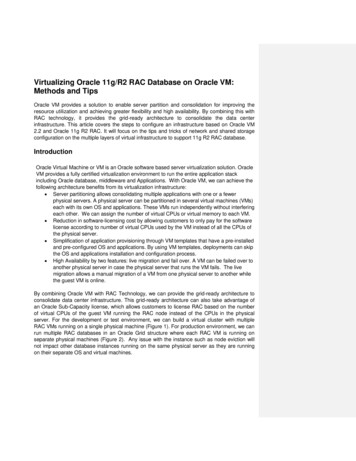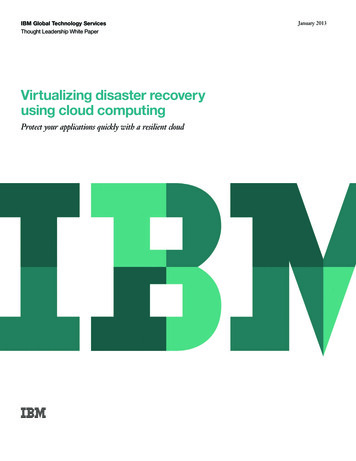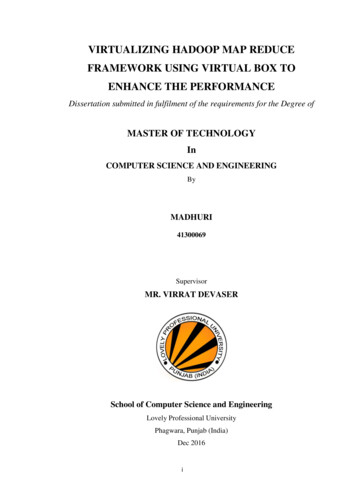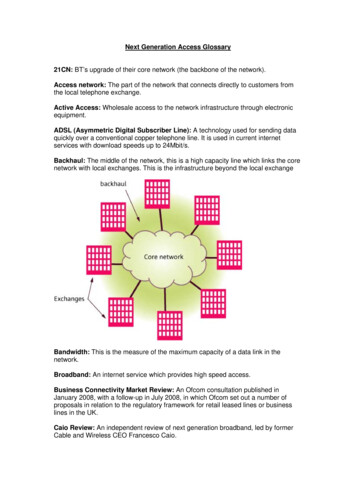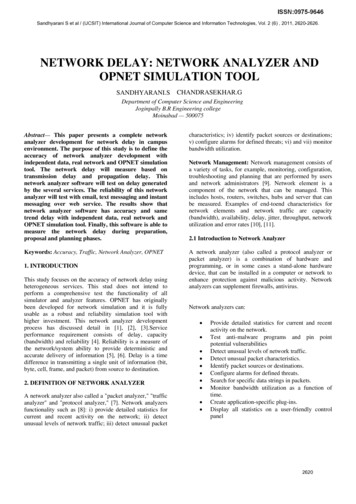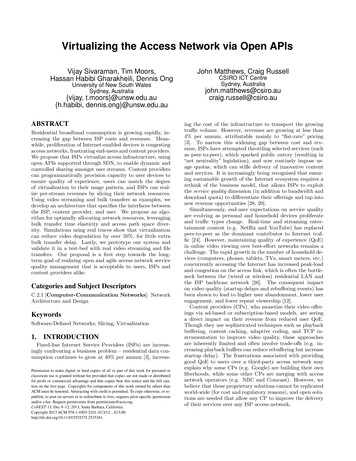
Transcription
Virtualizing the Access Network via Open APIsVijay Sivaraman, Tim Moors,Hassan Habibi Gharakheili, Dennis OngUniversity of New South WalesSydney, Australia{vijay, t.moors}@unsw.edu.au{h.habibi, dennis.ong}@unsw.edu.auABSTRACTResidential broadband consumption is growing rapidly, increasing the gap between ISP costs and revenues. Meanwhile, proliferation of Internet-enabled devices is congestingaccess networks, frustrating end-users and content providers.We propose that ISPs virtualize access infrastructure, usingopen APIs supported through SDN, to enable dynamic andcontrolled sharing amongst user streams. Content providerscan programmatically provision capacity to user devices toensure quality of experience, users can match the degreeof virtualization to their usage pattern, and ISPs can realize per-stream revenues by slicing their network resources.Using video streaming and bulk transfers as examples, wedevelop an architecture that specifies the interfaces betweenthe ISP, content provider, and user. We propose an algorithm for optimally allocating network resources, leveragingbulk transfer time elasticity and access path space diversity. Simulations using real traces show that virtualizationcan reduce video degradation by over 50%, for little extrabulk transfer delay. Lastly, we prototype our system andvalidate it in a test-bed with real video streaming and filetransfers. Our proposal is a first step towards the longterm goal of realizing open and agile access network servicequality management that is acceptable to users, ISPs andcontent providers alike.Categories and Subject DescriptorsC.2.1 [Computer-Communication Networks]: NetworkArchitecture and DesignKeywordsSoftware-Defined Networks; Slicing; Virtualization1. INTRODUCTIONFixed-line Internet Service Providers (ISPs) are increasingly confronting a business problem – residential data consumption continues to grow at 40% per annum [3], increasPermission to make digital or hard copies of all or part of this work for personal orclassroom use is granted without fee provided that copies are not made or distributedfor profit or commercial advantage and that copies bear this notice and the full citation on the first page. Copyrights for components of this work owned by others thanACM must be honored. Abstracting with credit is permitted. To copy otherwise, or republish, to post on servers or to redistribute to lists, requires prior specific permissionand/or a fee. Request permissions from permissions@acm.org.CoNEXT’13, Dec 9–12, 2013, Santa Barbara, California.Copyright 2013 ACM 978-1-4503-2101-3/13/12 . hn Matthews, Craig RussellCSIRO ICT CentreSydney, .auing the cost of the infrastructure to transport the growingtraffic volume. However, revenues are growing at less than4% per annum, attributable mainly to “flat-rate” pricing[3]. To narrow this widening gap between cost and revenue, ISPs have attempted throttling selected services (suchas peer-to-peer), which sparked public outcry (resulting in“net neutrality” legislation), and now routinely impose usage quotas, which can stifle delivery of innovative contentand services. It is increasingly being recognised that ensuring sustainable growth of the Internet ecosystem requires arethink of the business model, that allows ISPs to exploitthe service quality dimension (in addition to bandwidth anddownload quota) to differentiate their offerings and tap intonew revenue opportunities [28, 20].Simultaneously, end-user expectations on service qualityare evolving as personal and household devices proliferateand traffic types change. Real-time and streaming entertainment content (e.g. Netflix and YouTube) has replacedpeer-to-peer as the dominant contributor to Internet traffic [24]. However, maintaining quality of experience (QoE)in online video viewing over best-effort networks remains achallenge. The rapid growth in the number of household devices (computers, phones, tablets, TVs, smart meters, etc.)concurrently accessing the Internet has increased peak-loadand congestion on the access link, which is often the bottleneck between the (wired or wireless) residential LAN andthe ISP backbone network [26]. The consequent impacton video quality (startup delays and rebuffering events) hasbeen shown to lead to higher user abandonment, lower userengagement, and lower repeat viewership [12].Content providers (CPs), who monetize their video offerings via ad-based or subscription-based models, are seeinga direct impact on their revenue from reduced user QoE.Though they use sophisticated techniques such as playbackbuffering, content caching, adaptive coding, and TCP instrumentation to improve video quality, these approachesare inherently limited and often involve trade-offs (e.g. increasing playback buffers can reduce rebuffering but increasestartup delay). The frustrations associated with providinggood QoE to users over a third-party access network mayexplain why some CPs (e.g. Google) are building their ownfiberhoods, while some other CPs are merging with accessnetwork operators (e.g. NBC and Comcast). However, webelieve that these proprietary solutions cannot be replicatedworld-wide (for cost and regulatory reasons), and open solutions are needed that allow any CP to improve the deliveryof their services over any ISP access network.
Given the strong motivation for all parties (ISPs, users,and CPs) to want service quality capability in the network,one can rightly ask why it does not already exist. Indeed,user QoS/QoE has been studied extensively over the pasttwo decades, and many researchers (including the authors)have worked to develop numerous technical solutions rangingfrom ATM-SVC to RSVP and IntServ/DiffServ. However,we believe that the limited success of these prior frameworksis partly because they have not satisfactorily addressed twocritical aspects: (a) who exercises control over the servicequality? and (b) how is it monetized? These challenges areelaborated next.Control: Today, the control of network service quality islargely left to the ISP, who carefully hand-crafts policy anddevice configurations, likely via mechanisms (e.g. marking,policing, resource reservation, and queueing) from the DiffServ frameworks. Users have no visibility into the ISP’sdoings, and are left powerless and suspicious, wondering if“neutrality” is being violated (e.g. peer-to-peer traffic being de-prioritized). Further, exposing controls to the useralso raises challenges around user expertise needed to configure and manage QoS. At the other end, CPs can exertlittle (if any) control over service quality in ISP networkstoday. They do not have access to end-to-end quality assurance frameworks (e.g. RSVP/IntServ based) since ISPsdeem them either too onerous to operate or too dangerousto expose; at best CPs can indicate relative priority levelsfor their packets (e.g. via DiffServ code-points), but theseassurances are “soft”, being qualitative and subject to othertraffic in the network. These concerns exacerbate furtherwhen the ISP and CP do not peer directly, i.e. connect viaa transit provider. Any viable quality enhancement solutiontherefore has to tackle the issue of how the control is sharedamongst the various players involved.Monetization: An ISP has little incentive to deploy service quality mechanisms unless there is a monetary return.Consumers are very price sensitive, and it is unclear if sufficient consumers will pay enough for the QoS enhancement toallow the ISP to recoup costs. CPs potentially have greaterability to pay; however, current “paid peering” arrangementsare based on aggregate metrics such as transfer volume ortransfer rate. A CP is unlikely to pay more for “wholesale”improvement in service quality, especially if a non-negligiblefraction of their traffic gets delivered at adequate qualityanyway. A viable QoS solution should therefore allow theCP to make fine-grained (e.g. per-flow) decisions in an agileway so that service quality can be aligned with their business models. For example, the CP may want to deliver trafficonly for certain customers or certain content at high quality,and these decisions can vary dynamically (e.g. depending ontime-of-day or loss/delay performance of the network).The above two challenges have been poorly addressed inearlier frameworks, dissuading ISPs from deploying servicequality mechanisms and causing frustration for CPs andend-users. We believe that the emerging paradigm of software defined networking (SDN) provides us a new opportunity to overcome this old impasse. Logical centralizationof the control plane under SDN helps in many ways:1. A central “brain” for the network makes it easier forthe ISP to expose (e.g. via APIs) service quality controls needed by an external party, such as the CP. Webelieve that a software-driven API is a far superiormethod for information exchange rather than inter-connecting existing protocols (e.g. RSVP) to external parties, since (a) protocols often reveal information (e.g. network topology or network state) thatis both private to the ISP and unnecessary for theexternal entity, whereas APIs can be crafted specifically for the negotiation task at hand, (b) protocolsdo not easily straddle transit domains, whereas APIscan be invoked by a remote entity that does not peerdirectly with the ISP, and (c) protocols are typicallydistributed across network elements and take longerto converge whereas APIs implemented at the centralcontroller can respond rapidly to external requests. Webelieve that the above advantages of APIs make SDNa more suitable paradigm by which the ISP can exposeand share QoS control with external entities.2. The centralized brain in SDN is more amenable for optimal decision making. Since the SDN controller hasa global view of resources, it can make informed decisions based on current availability and requests. Indeed, the resource management algorithm we developin this paper has a provable performance bound, whichis difficult to achieve in distributed systems that havelimited visibility into global state.3. Lastly, SDN provides a cross-vendor solution that doesnot require protocol support from the various forwarding elements. The resource partitioning can be executed by the centralised software across any forwarding element over any access technology that supportsa standardized SDN interface such as OpenFlow.At a high level, our solution encourages the ISP to “virtualize” the access network, namely partition the last-mile network bandwidth resources dynamically amongst flows, usingSDN. The virtualization is driven by open APIs that are exposed to external entities (CPs in our case), who can chooseto invoke it to negotiate service quality with the network ona per-flow basis. For the ISP, the API offers a monetizationopportunity, while protecting sensitive internal information,and giving them the freedom to innovate mechanisms formaximizing resource usage (for example by “pooling” WiFiresources in a neighborhood). For CPs, the API providesan enforceable assurance from the access network, and thepay-as-you-go model gives them freedom to align quality requirements with their business models. For users, we equipthem with a simple control into the degree to which theiraccess network resources are pooled/partitioned, allowingthem to match it to their usage patterns. While past experience has taught us that any large-scale deployment of QoSfaces significant practical obstacles, we believe our solutionapproach has the potential to overcome the business, regulatory and administrative impediments, and offers the rightset of incentives for ISPs, CPs and users to collaborate forits success.Our specific contributions are as follows. We use videostreaming and file transfers as two motivating examples, anddevelop a system architecture that virtualizes the last-mileaccess infrastructure to allow controlled and efficient sharing amongst user application streams. CPs can programmatically provision capacity on the access links to end-userdevices at short time-scales to ensure consistent quality ofexperience for users; ISPs can realize per-stream revenuesby dynamically reconfiguring their access network in an agile way; and users can choose their degree of participation
by tuning a single parameter. We develop an algorithm foroptimal resource allocation in the access network, leveraging scheduling in the time dimension (that allows non-timecritical elastic traffic such as bulk transfers to be deferredin favour of time-sensitive streaming traffic) as well as inthe space dimension (by pooling bandwidth from multiplewireless access points in a neighborhood). We then evaluate the efficacy of our algorithm in improving service quality via simulations of real traces of over 10 million flowstaken from a large enterprise network. Lastly, we prototypeour system using commercial switches and commodity accesspoints, and demonstrate the benefits of our scheme via experiments in a test-bed emulating three residences runningreal applications. Our work presents a first step towards aviable and pragmatic approach to delivering service qualityin access networks in a way that is beneficial to ISPs, users,and CPs alike.The rest of the paper is organized as follows: §2 describesthe use-cases considered in this paper. §3 describes our system architecture, trade-offs, and algorithm. In §4 we evaluate our system via simulation with real traffic traces, while§5 describes the prototype development and experimentation. Relevant prior work is summarized in §6, and the paperconcludes in §7.2. USE-CASES AND OPPORTUNITIESThe set of applications that can benefit from explicit network support for enhanced service quality is large and diverse: real-time and streaming videos can benefit from bandwidth assurance, gaming applications from low latencies,voice applications from low loss, and so on. In this paperwe start with two application use-cases: real-time/streamingvideo, chosen due to its growing popularity with users andmonetization potential for providers, and (non-real-time)bulk transfers, chosen for their large volume and high valueto users. The APIs we develop and demonstrate for theseuse-cases will help illustrate the value of our approach, andcan be extended in future work for other application types.2.1 Real-Time / Streaming VideoOnline video content, driven by providers such as Netflix,YouTube, and Hulu, is already a dominant fraction of Internet traffic today, and expected to rise steeply in comingyears. As video distribution over the Internet goes mainstream, user expectations of quality have dramatically increased. Content providers employ many techniques to enhance user quality of experience, such as CDN selection [15],client-side playback buffering [22], server-side bit-rate adaptation [2], and TCP instrumentation [6]. However, largescale studies [5, 12] have confirmed that video delivery quality is still lacking, with startup delays reducing customerretention and video “freeze” reducing viewing times. Sincevariability in client-side bandwidth is one of the dominantcontributors to quality degradation, an ideal solution is to“slice” the network to explicitly assure bandwidth to thevideo stream. Eliminating network unpredictability will (a)reduce playback buffering and startup delays for streaming video, (b) benefit live/interactive video streams that arelatency bound and cannot use playback buffering, and (c)minimise the need for sophisticated techniques such as bandwidth estimation and rate adaptation used by real-time andstreaming video providers.There are however important questions to be addressed inrealizing the above slicing solution: (a) what interaction isneeded between the application and the network to triggerthe bandwidth reservation? (b) is the bandwidth assuredend-to-end or only on a subset of the path? (c) which entitychooses the level of quality for the video stream, and whopays for it? (d) what rate is allocated to the video streamand is it constant? (e) what is the duration of the reservationand how is abandonment dealt with? and (f) how agile isthe reservation and can it be done without increasing startup delays for the user? Our architecture presented in §3 willaddress these non-trivial issues.2.2Bulk TransferAfter video, large file transfers are the next biggest contributors to network traffic. Examples include peer-to-peerfile-sharing, video downloads (for offline viewing), softwareupdates, and cloud-based file storage systems [24]. Unlikevideo, bulk transfers do not need a specific bandwidth, anduser happiness generally depends on the transfer being completed within a “reasonable” amount of time. This “elasticity” creates an opportunity for the ISP to dynamically sizethe network bandwidth “slice” made available to bulk transfers, based on other traffic in the network. This can allowthe ISP to reduce network peak load, which is a dominantdriver of capital expenditure, and release capacity to admit more lucrative traffic streams (e.g. real-time/streamingvideo) requiring bandwidth assurances.Though the idea of “shifting” bulk transfer traffic to lowload periods based on their elasticity is conceptually simple,there are challenges around (a) how to identify bulk transferparameters such as size and elasticity? (b) how to incentivizethe user/provider to permit such shifting? and (c) how todimension the network resource slice for this elastic traffic?These are addressed in §3.2.3WiFi PoolingAnother opportunity that can be leveraged, particularlyfor bulk transfers, is that in urban areas the density of wireless access points (APs) is high – often 6 or more WiFi networks are visible at a typical location [10]. An ISP witha sufficiently high density of penetration in a neighborhoodmay therefore have available multiple paths, each via a different AP, by which data can be sent to a specific householddevice. As an example, the user’s iPad may be streamingvideo via her home AP, while simultaneously her smart-TVor media gateway, which may be downloading large contentfor later viewing, could be made to do so via a neighbor’slightly loaded AP. This “off-loading” of traffic to alternatepaths leads to more efficient use of access link resources,and motivates us to propose that the entire access networkinfrastructure be virtualized by treating it as a pool of resources, rather than limiting a household to one access link.The ability to pool WiFi resources has many challenges,including determination of signal strengths and data rates,management of migrations of user clients across APs, andconsiderations around security, quota, charging, and fairness. However, several operators world-wide, such as Oi inBrazil, Ziggo B.V. in the Netherlands, Telefonica in Spain,and Comcast in the US, are surmounting these challengesas they prepare to convert their users’ homes into hotspots[14] to pool their WiFi resources. We will leverage these
methods, additionally using SDN to steer traffic along thedesired path in the pooled WiFi network.Content providerSDN ControllerInternet3. SYSTEM ARCHITECTURE AND ALGORITHMMotivated by the above use-cases, we now propose a system architecture for virtualizing the access network. Wefirst outline the major architectural choices and trade-offs(§3.1), then describe the operational scenario (§3.2), and finally develop the detailed mechanisms and algorithms forvirtualization (§3.3).APIAntivirus UpdateContent providerISP NetworkDSLAM/Head-EndOpenFlow SwitchHomeGateway3.1 Architectural Choices and Trade-OffsThe aim of virtualization is to partition resources dynamically amongst flows in a programmatic way, so that the network is used as efficiently as possible for enhancing application performance or reducing cost. We briefly discuss whyopen APIs are needed to achieve the virtualization, whatpart of the network is virtualized, and who exercises controlover the virtualization.Why Open APIs: Current mechanisms used by ISPsto partition network resources require cripplingly expensivetools for classifying traffic flows (e.g. using DPI), encourageapplications to obfuscate or encrypt their communications,and risk causing public backlash and regulation. Therefore,we advocate that the virtualization be driven externally viaan explicit API open to all CPs. This allows CPs to choosea resource requirement commensurate with the value of theservice, while letting ISPs explicitly obtain service attributeswithout using DPI.What is Virtualized: Assuring application performanceideally requires end-to-end network resource allocation. However, past experience with end-to-end QoS frameworks hastaught us that getting the consensus needed to federateacross many network domains is very challenging. In thispaper we therefore focus on the achievable objective of partitioning resources within a single domain. A natural choice isthe last-mile access network as there is evidence [26, 9] thatbottlenecks often lie here and not at the interconnects between networks. Our solution can in principle be adapted toany access technology, be it dedicated point-to-point (DSL,PON) or shared (e.g. cable, 3G). In this paper we focusour theoretical formulation and evaluation on point-to-pointwired access technologies, wherein each subscriber has a dedicated bandwidth, and overlay it with WiFi pooling to allowsharing of bandwidth across residences. The case of sharedmedia (cable or 3G) deserves a separate discussion aroundthe policies needed to be fair to different users who embracethe virtualization scheme to different extents, and is left forfuture work.Who Controls the Virtualization: Though the virtulization APIs can be invoked by any entity, we envisage initial uptake coming from CPs rather than consumers, since:(a) uptake is needed by fewer, since as much of 60% of Internet traffic comes from 5 large content aggregators [9], (b)CPs have much higher technical expertise to upgrade theirservers to use the APIs, and (c) client-side charging for APIusage can significantly add to billing complexity. For thesereasons, we expect CPs to be the early adopters of the virtualization APIs, and defer consumer-side uptake to futurestudy. Figure 1: Network topologyThe end-user still needs to be empowered with a meansto control the virtualization, e.g. a user might not want herweb-browsing or work-related application performance to beoverly affected by streaming video that her kids watch. Wetherefore propose that each household be equipped with asingle parameter α [0, 1] which is the fraction of its accesslink capacity that the ISP is permitted to virtualize. Setting α 0 disables virtualization, and the household continues to receive today’s best-effort service. Households thatvalue video quality could choose a higher α setting, whilehouseholds wanting to protect unpaid traffic (web-browsingor peer-to-peer) can choose a lower α. Higher α can potentially reduce the household Internet bill since it gives theISP more opportunity to monetize from CPs. Our work willlimit itself to studying the impact of α on service qualityfor various traffic types; determining the best setting for ahousehold will depend on its Internet usage pattern and therelative value it places on the streams, which is beyond thescope of this study.3.2Operational ScenarioWe briefly describe the operational scenario, the referencetopology, the flow of events, the API specifications, and theroles of the CP and the user.3.2.1Topology and Flow of EventsFig. 1 shows a typical access network topology. Each residence has a wireless home gateway to which household devices connect. The home gateway offers Internet connectivity via a broadband link (e.g. DSL or PON), connecting toa line termination device at the ISP local exchange, whichis in turn back-ended by an Ethernet switch that has SDNcapability. The Ethernet switches at each local exchangeconnect via metro- or wide-area links to the ISP’s backhaulnetwork. The ISP network houses an SDN controller thatexposes the APIs discussed below, and executes the virtualization algorithm (described at the end of this section) toreconfigure the network. The ISP network can either peerdirectly, or via other ISPs, to content providers that sourcethe data that is consumed by users. Our solution worksequally well when the data is sourced from CDNs or contentcaches within or outside the ISP network.
The operational flow of events is as follows. The user’s request for content (e.g. YouTube video link click or Dropboxfile transfer command) goes to the CP, who can instantlycall the API into the ISP network to associate resources forthis flow. If the negotiation succeeds, the ISP assures thoseresources for the flow, and charges the CP for it. In whatfollows we describe the APIs in more detail and elaborateon the specific actions required by the CP and the user.3.2.2 The APIsWe now develop minimalist specifications of the APIs forthe two use-cases considered in this paper; detailed specifications are left for future standardization.API for Bandwidth Assurance: This specifies: (a)Caller id: The identity of the entity requesting the service.Authentication of some form (such as digital signature of themessage) is assumed to be included, but we do not discusssecurity explicitly in this work. (b) Call Type: A type fieldindicates the service being requested, in this case minimumbandwidth assurance. (c) Flow tuple: The 5-tuple comprising the IP source and destination addresses, the transportprotocol, and the source and destination port numbers, thatidentify the flow (consistent with the OpenFlow specification). Note that wildcards can be used to denote flow aggregates. (d) Bandwidth: The bandwidth (in Mbps) thatis requested by the flow. (e) Duration: The duration (inseconds) for which the bandwidth is requested.This API assures minimum bandwidth to a service likevideo streaming. Note that the flow can avail of extra bandwidth if available, and is not throttled or rate-limited bythe network. Further, we have intentionally kept it simpleby using a single bandwidth number, rather than multiple(e.g. peak and average) rates. The value to use is left to theCP, who knows best their video stream characteristics (peakrate, mean rates, smoothness, etc.) and the level of qualitythey want to support for that particular session. The duration of the bandwidth allocation is decided by the caller.To combat abandonment, the CP may choose to reserve forshort periods (say a minute) and renew the reservation periodically; however, this runs the risk of re-allocation failures.Alternatively, the caller can choose to reserve for longer periods, and the APIs can be extended to include cancellation ofan existing reservation. These implementation decisions areleft for future standardization. Lastly, the ISP will chargethe caller for providing bandwidth assurance to the stream.The pricing model is left to the individual ISP, and can bedynamic (depending on time-of-day, congestion levels, etc.).We do not know, or dare to put, a price on bandwidth –that will ultimately be determined by market forces.API for Bulk Transfer: This includes: (a) Caller id:as before. (b) Call Type: in this case bulk transfer. (c)Flow tuple: as before. (d) Size: The volume of data to betransferred, in MegaBytes. (e) Deadline: The duration (inseconds) by which the transfer is requested to be completed.This API is for large data transfers that are not time critical. The elasticity can be leveraged by the ISP to reducepeak demand [20], and the monetary benefit can be passedon to the CP in the form of a lower per-byte transfer cost. Inturn, the CP may pass on the discount to the user, such as bycharging them less for downloading a movie for later viewing than for streaming it in real-time. The CP can eithersolicit the deadline parameter directly from the user (via theapplication’s interface), or deduce it implicitly (from priorknowledge about the user), as elaborated further below.One conceivable way by which the ISP can schedule bulktransfers is to warehouse the data, i.e. move it from theCP to the ISP, and then on to the user at a suitably scheduled time. However, this carries with it complexities (suchas proxies, split connections) and liabilities (e.g. pirateddata). We instead propose that the ISP dynamically adjust the network path and bandwidth made available to thebulk transfer, without having to store any content. Thiseliminates complexities and liabilities for the ISP, lets theminnovate (and protect) their mechanisms for path selectionand bandwidth adjustment, and does not require any userclient changes.3.2.3Changes for Content Provider and UserThe changes required at the content servers are well-withinthe technical expertise of the CPs. They can identify aclient’s ISP based on the client IP address, and a DNS entry can be created for the controller advertised by that ISP.We note that the CP has full visibility of the flow end-points(addresses and ports), irrespective of whether the home usesNAT or not. For streaming video, the bandwidth requirement can be deduced from the format and encoding of thecontent. For bulk transfers, delay bounds can either be explicitly solicited from the user (via an option in the application user interface) or chosen based on previously acquiredknowledge about the consumer (e.g. deadlines to ensure delivery before prime time viewing). Lastly, CPs are at libertyto align the API usage with their business models, such asby invoking it only for premium customers.Subscribers are provided with a single knob α [0, 1] thatcontrols the fraction of their household link capacity thatthe ISP is permitted to virtualize, adjusted via their account management portal. This parameter can be tuned bythe user to achieve the desired trade-off between quality forreserved (video/bulk) flows and unreserved (browsing/peerto-peer) flows. Where WiFi pooling is employed, we do notmandate any changes to user clients or applications to facilitate migration of traffic across access points (such as multihoming [7] or proxying tech
C.2.1 [Computer-Communication Networks]: Network Architecture and Design Keywords Software-Defined Networks; Slicing; Virtualization 1. INTRODUCTION . A central "brain" for the network makes it easier for the ISP to expose (e.g. via APIs) service quality con-trols needed by an external party, such as the CP. .



